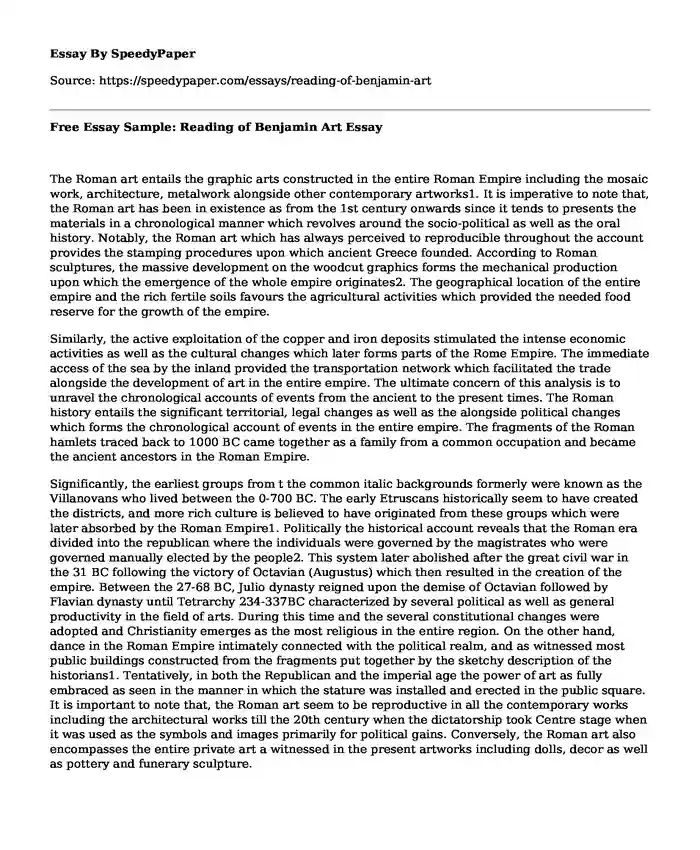
| Type of paper: | Essay |
| Categories: | Art Roman Empire |
| Pages: | 3 |
| Wordcount: | 664 words |
The Roman art entails the graphic arts constructed in the entire Roman Empire including the mosaic work, architecture, metalwork alongside other contemporary artworks1. It is imperative to note that, the Roman art has been in existence as from the 1st century onwards since it tends to presents the materials in a chronological manner which revolves around the socio-political as well as the oral history. Notably, the Roman art which has always perceived to reproducible throughout the account provides the stamping procedures upon which ancient Greece founded. According to Roman sculptures, the massive development on the woodcut graphics forms the mechanical production upon which the emergence of the whole empire originates2. The geographical location of the entire empire and the rich fertile soils favours the agricultural activities which provided the needed food reserve for the growth of the empire.
Similarly, the active exploitation of the copper and iron deposits stimulated the intense economic activities as well as the cultural changes which later forms parts of the Rome Empire. The immediate access of the sea by the inland provided the transportation network which facilitated the trade alongside the development of art in the entire empire. The ultimate concern of this analysis is to unravel the chronological accounts of events from the ancient to the present times. The Roman history entails the significant territorial, legal changes as well as the alongside political changes which forms the chronological account of events in the entire empire. The fragments of the Roman hamlets traced back to 1000 BC came together as a family from a common occupation and became the ancient ancestors in the Roman Empire.
Significantly, the earliest groups from t the common italic backgrounds formerly were known as the Villanovans who lived between the 0-700 BC. The early Etruscans historically seem to have created the districts, and more rich culture is believed to have originated from these groups which were later absorbed by the Roman Empire1. Politically the historical account reveals that the Roman era divided into the republican where the individuals were governed by the magistrates who were governed manually elected by the people2. This system later abolished after the great civil war in the 31 BC following the victory of Octavian (Augustus) which then resulted in the creation of the empire. Between the 27-68 BC, Julio dynasty reigned upon the demise of Octavian followed by Flavian dynasty until Tetrarchy 234-337BC characterized by several political as well as general productivity in the field of arts. During this time and the several constitutional changes were adopted and Christianity emerges as the most religious in the entire region. On the other hand, dance in the Roman Empire intimately connected with the political realm, and as witnessed most public buildings constructed from the fragments put together by the sketchy description of the historians1. Tentatively, in both the Republican and the imperial age the power of art as fully embraced as seen in the manner in which the stature was installed and erected in the public square. It is important to note that, the Roman art seem to be reproductive in all the contemporary works including the architectural works till the 20th century when the dictatorship took Centre stage when it was used as the symbols and images primarily for political gains. Conversely, the Roman art also encompasses the entire private art a witnessed in the present artworks including dolls, decor as well as pottery and funerary sculpture.
Bibliography
Murphy, Thomas F. "The God of War: Napoleonic Appropriation of Greco-Roman Art, Architecture, and Iconography." PhD diss., San Diego State University, 2018.
Hall, James. Illustrated dictionary of symbols in Eastern and Western art. Routledge, 2018.
Ostman, Lars. "Language and Materiality: Stolpersteine in Light of Roman Archaic Religion." In Religion and Material Culture: Studying Religion and Religious Elements on the Basis of Objects, Architecture, and Space: Proceedings of an International Conference held at the Centre for Bible and Cultural Memory (BiCuM), University of Copenhagen and the National Museum of Denmark, Copenhagen, May 6-8, 2011, pp. 341-361.
Cite this page
Free Essay Sample: Reading of Benjamin Art. (2022, Aug 05). Retrieved from https://speedypaper.com/essays/reading-of-benjamin-art
Request Removal
If you are the original author of this essay and no longer wish to have it published on the SpeedyPaper website, please click below to request its removal:
- Essay Example with Fitness Industry Analysis
- Free Essay on Corporate Communications: Immigration Reform
- Al-Shabaab and US National Security - Free Essay for Everyone
- Essay Example about Anthropology Deconstruction of a Food Dish
- Essay Sample on Philosophy of the Law
- Free Essay on Decision-Making and Consumer Behavior
- Paper Example. Interoperability Practices
Popular categories




